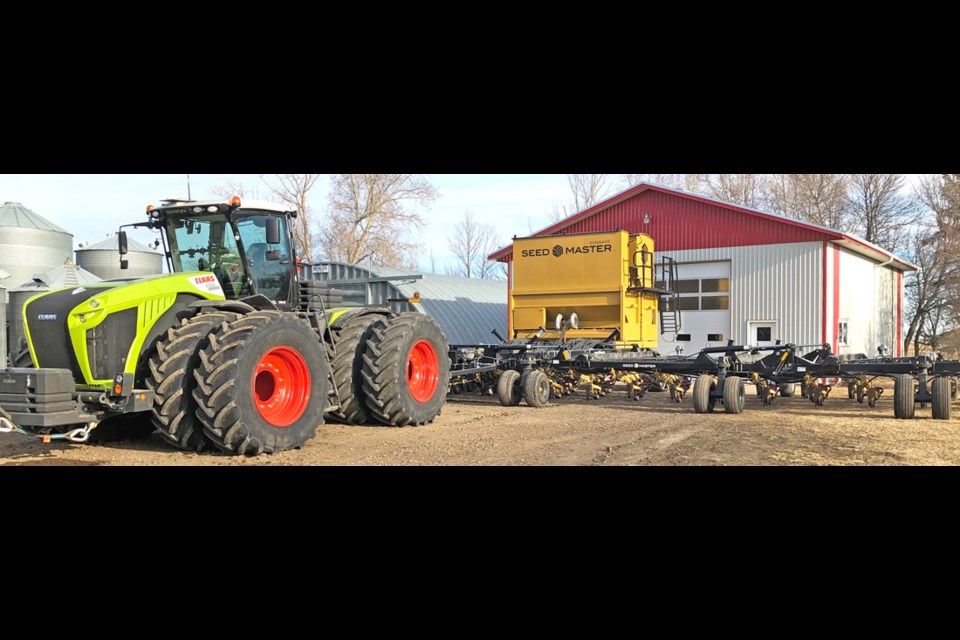The weather is starting to warm up and the fields are drying up in southeast Saskatchewan, which will enable farmers like Creelman-area producer Marcel Van Staveren to get out into the fields and start seeding soon.
“We plan to be in the fields by around April 28,” he said, noting they are getting the equipment and inputs in place to start applying anhydrous ammonia as early as April 25, if the conditions allow.
“We’ll do a couple weeks of that with a couple of tractors, and it will overlap some of our seeding when we start with that,” said Van Staveren, who farms with his two brothers in the Creelman-Fillmore area.
About one per cent of last fall’s crops are still in the field, and his son Nathan was out combining canola on Friday and Monday to clean those fields up before seeding begins, he added.
The family bought some land in the past year, so they will have about 22,000 acres altogether to seed this spring. If the weather cooperates, it will take about three solid weeks of work to get it all planted.
As a large family operation, they are very much aware of the threat of the COVID-19 pandemic, and they have been very attentive to the procedures they will be using during seeding in order to stay safe.
One effect they are monitoring is whether there will be a second wave of COVID-19 infections, he said. “There could be supplier issues. We need supplies at the field. We have P&H deliver it to our tractors in the field.”
As far as soil moisture, Van Staveren notes that the water table in the Creelman-Fillmore area is quite high and moisture levels are in perfect shape right now. The wet fall delayed harvesting, but there has not been much moisture through the winter, which is a good thing considering how wet the soil was, he added.
Asked if their farms have an adequate labour force for seeding, he said they have two Mexican Mennonite families who have come up, and are just finished their mandatory 14-day quarantine without any sickness.
“They had no issues coming across the U.S. into Canada. They have Canadian citizenship, as they are dual citizens,” he said.
With the staff and family, the farm operation has about 14-15 people working through the seeding, with three air drills going and switching shifts off on each.
With COVID-19 in mind, they are going to have each crew member stay with just one tractor seeding unit, and at the end of each shift they will wipe down all surfaces that were touched.
“We’re going to keep the same three people on each tractor and each drill, so if there are any health issues, we won’t have any musical chairs. There will be sanitizing and cleaning of each tractor at the end of each shift,” said Van Staveren, noting there are computer touch-screens, gear levers and steering wheels as well as other hard surfaces in the tractor cab that will all get wiped down.
He noted a farmer friend of his sent his crews home on April 15 to quarantine themselves, so at the end of it all the crew can be back at work and ready to go by May 1st, assuming they are all healthy at that time.
As an additional safety issue, the seeding crews have to handle anhydrous ammonia, so they have to observe safety protocols with that, including wearing of masks to protect from the dangerous gases.
As for what they will be planting, they largely made their seeding plans in November, and tweaked them as markets warranted while mostly following their crop rotation plans.
They have increased their lentils acreage as the commodity price has improved to be well above average, said Van Staveren. “No doubt it’s driven by COVID-19, as there’s more demand for lentils.”
While there are market issues for canola, he said their acres will be fairly consistent, and they will hope for high yields so the crop will still be worth planting.
Prices for milling wheat are fairly good, and durum wheat prices are particularly good right now, he added, and they will cut back on their soybean acres.
They will seed about 8,000 acres of canola, 5,500 to durum, 3,500 acres will have hard red spring heat, and about 5,100 will be seeded to red lentils.
A plus for this spring is that some of their input costs will be lower, such as for diesel fuel and fertilizer, compared to last year’s prices, he added.
“However small the victories are, we need to celebrate them. Ultimately the soil conditions are good, but if we get too much rain during seeding, it will be a big problem,” he said.




